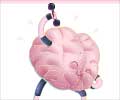A previously unknown protein in muscles that spurs their growth and increases power following resistance exercise has been isolated

Mice given extra doses of the protein gained muscle mass and strength, and rodents with cancer were much less affected by cachexia, the loss of muscle that often occurs in cancer patients, according to the report in the Dec. 7 issue of the journal Cell.
"This is basic science at present," commented Jorge Ruas, PhD, first author of the report. "But if you could find a way to elevate levels of this protein, that would be very exciting. For example, you might be able to reduce muscle wasting in patients in intensive care units whose muscles atrophy because of prolonged bed rest." Other applications, he said, might be in disorders such as muscular dystrophy and the gradual loss of muscle mass from aging.
Bruce Spiegelman, PhD, the senior author, led the Dana-Farber team that identified the protein, PGC-1 alpha-4, in skeletal muscle and said it is present in mice and humans. Resistance exercise, such as weight lifting, causes a rise in PGC-1 alpha-4, which in turn triggers biochemical changes that make muscles larger and more powerful, said the researchers.
The protein is an isoform, or slight variant, of PGC-1 alpha, an important regulatory of body metabolism that is turned on by forms of exercise, such as running, that increase muscular endurance rather than size. "It''s pretty amazing that two proteins made by a single gene regulate the effects of both types of exercise," commented Spiegelman.
The researchers found that the new protein controls the activity of two previously known molecular pathways involved in muscle growth. A rise in PGC-1 alpha-4 with exercise increases activity of a protein called IGF1 (insulin-like growth factor 1), which facilitates muscle growth. At the same time, PGC-1alpha4 also represses another protein, myostatin, which normally restricts muscle growth. In effect, PGC-1 alpha-4 presses the accelerator and removes the brake to enable exercised muscles to gain mass and strength.
Advertisement
Several experiments demonstrated the muscle-enhancing effects of the novel protein. The investigators used virus carriers to insert PGC-1 alpha-4 into the leg muscle of mice and found that within several days their muscle fibers were 60 percent bigger compared to untreated mice. They also engineered mice to have more PGC-1 alpha-4 in their muscles than normal mice who were not exercising. Tests showed that the treated mice were 20 percent stronger and more resistant to fatigue than the controls; in addition, they were leaner than their normal counterparts.
Mice engineered to have extra PGC-1 alpha-4 showed "dramatic resistance" to cancer-related muscle wasting, the scientists found. The mice lost only 10 percent mass in a leg muscle compared to a 29 percent loss in mice with cancer that did not have additional PGC-1 alpha-4, according to the report. The altered mice were also stronger and more active than the normal mice.
Advertisement
The research was supported by NIH grant DK061562 and a grant from Novartis.
Dana-Farber Cancer Institute (www.dana-farber.org) is a principal teaching affiliate of the Harvard Medical School and is among the leading cancer research and care centers in the United States. It is a founding member of the Dana-Farber/Harvard Cancer Center (DF/HCC), designated a comprehensive cancer center by the National Cancer Institute. It provides adult cancer care with Brigham and Women''s Hospital as Dana-Farber/Brigham and Women''s Cancer Center and it provides pediatric care with Boston Children''s Hospital as Dana-Farber/Children''s Hospital Cancer Center. Dana-Farber is the top ranked cancer center in New England, according to U.S. News & World Report, and one of the largest recipients among independent hospitals of National Cancer Institute and National Institutes of Health grant funding. Follow Dana-Farber on Twitter: @danafarber or Facebook: facebook.com/danafarbercancerinstitute.
Source-Newswise















